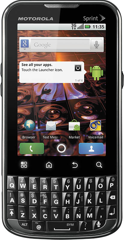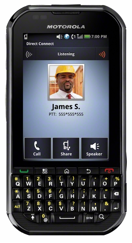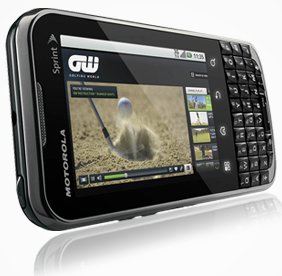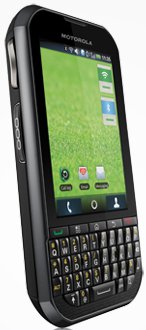Motorola and Sprint reveal two business-focused Android phones
May 5, 2011 — by Eric Brown — from the LinuxDevices Archive — viewsMotorola Mobility and Sprint announced two enterprise-focused Android smartphones with 3.1-inch touchscreens, exposed QWERTY keyboards, and five-megapixel cameras. The Motorola Xprt is a 1GHz Android 2.2 phone with enterprise security features and international roaming, and the ruggedized, Android 2.1-based Motorola Titanium makes use of Sprint's Nextel Direct Connect Push-to-Talk network, says Sprint.
Motorola Mobility has increasingly targeted the enterprise market for Android phones, offering business-travel focused global roaming phones like the Droid 2 Global. Motorola has also introduced rugged field-service models such as the Defy, and push-to-talk phones supporting Sprint's iDEN-ready Nextel Direct Connect service like the Motorola i1.


Motorola Xprt (left) and Titanium
Motorola Xprt
The Motorola Xprt is aimed at enterprise managers and workforces across field service, field sales, healthcare, retail, utilities, manufacturing and transportation/distribution industries, says Sprint. The phone offers security features based on 256-bit AES data encryption, as well as the ability to remotely handle functions like enabling pin or password lock, password recovery, and data wipe on both the phone and SD card, the carrier adds.
Equipped with an unnamed 1GHz processor, the phone offers a modest 3.1-inch HVGA (480 x 320 pixel) pinch-to-zoom capable touchscreen. Beneath the display is a full, although tiny, QWERTY keyboard.

Motorola Xprt
The phone operates on both CDMA (EVDO Rev. A) and GSM/UMTS (HSPA) cellular networks, enabling international roaming service in more than 200 countries, says Sprint. Other wireless communications are said to include 802.11b/g/n Wi-Fi, Bluetooth 2.1 + EDR, and GPS.
A 3G Mobile hotspot capability is offered, supporting up to five Wi-Fi enabled devices simultaneously. Sprint did not list the hotspot pricing, but these services typically run about $20 a month. (There might not be any more bandwidth sharing freebies, however, as this week Google gave in to carrier demands to suppress wireless tethering apps in Android Market.)
The 4.74 x 2.4 x 0.51-inch phone weighs 5.1 ounces, says Sprint. The Xprt is said to offer up to nine hours of talk time on its 1860mAh battery. The Android 2.2 stack offers Adobe Flash 10, Android Market, and Google services including Google Maps with Navigation. Other features are said to include Microsoft Exchange ActiveSync, POP and IMAP email, and Quickoffice productivity apps.
The Xprt features the MotoBlur UI skin, which offers email and social media updates. MotoBlur also provides news feeds, updates, and messages from social media sites integrated on a single screen, says Sprint.
Motorola Titanium
The Titanium is billed as the successor to Sprint's aforementioned Motorola i1, and similarly runs on Sprint's iDEN-ready Nextel Direct Connect push-to-talk service. Like the Xprt, the Android 2.1 phone is equipped with a 3.1-inch HVGA pinch-to-zoom touchscreen, as well as a tiny QWERTY keyboard.
 Like the Xprt the Titanium is pointed toward enterprise field duties, but with its push-to-talk functionality and rugged build, it's aimed more at the worksite than the office. The Titanium (pictured) is certified to MIL-STD 810G for resisting dust, shock, vibration, low pressure, solar radiation, high temperature, and low temperature, says Sprint.
Like the Xprt the Titanium is pointed toward enterprise field duties, but with its push-to-talk functionality and rugged build, it's aimed more at the worksite than the office. The Titanium (pictured) is certified to MIL-STD 810G for resisting dust, shock, vibration, low pressure, solar radiation, high temperature, and low temperature, says Sprint.
No processor is mentioned, which suggests the Titanium may be less powerful than the Xprt's 1GHz. Like the Xprt, the phone features a 2GB microSD card for a 32GB-ready slot.
A five-megapixel camera is available with camcorder, 4x zoom, and flash, says Sprint. The Titanium also supplies 802.11b/g, Bluetooth 2.1 + EDR, and GPS, says the company.
Just slightly larger than the Xprt, the Titanium is said to measure 4.71 x 2.44 x 0.53 inches, and weigh 5.2 ounces. A 1820mAh battery offers 275 minutes of talk time, says Sprint.
The Titanium supports Nextel Direct Connect Services, including Direct Connect, Group Connect, International Direct Connect, DirectSend, Group Messaging and NextMail, says Sprint. Although the Titanium runs Android 2.1 instead of 2.2, it offers much the same software as the Xprt. The main difference is the lack of any mention of MotoBlur, and of course no Adobe Flash support.
Availability
The Motorola Xprt will be available June 5 for $130 with a new line or eligible upgrade and two-year service agreement, says Sprint. Pricing and availability for Motorola Titanium will be announced at a later date.
More information on the Motorola Xprt may be found on this Sprint page, as well as a Motorola page that offers fewer details but more photos. More on the Motorola Titanium may be found on this Sprint page and the similarly spec-deprived but media-imbued Motorola page.
This article was originally published on LinuxDevices.com and has been donated to the open source community by QuinStreet Inc. Please visit LinuxToday.com for up-to-date news and articles about Linux and open source.